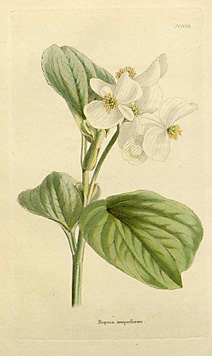Bourgeois Begonia
By Audrey Stallsmith

And some can pot begonias and some can bud a rose,
And some are hardly fit to trust with anything that grows;
from "The Glory of the Garden" by Rudyard Kipling
Although I usually don’t begin sowing seeds until mid-February, I should probably start the begonias sooner. I’ve received several different types this year, either from trades or generous garden friends, and begonia seeds are dust-mote tiny. So the seedlings can be, to put it rhymingly, slow to grow.
Despite there being over 1500 species of wild begonias, some of which make their home on every continent except Australia, those plants were slow to be discovered as well. The 1800s proved to be their time to shine, with the hardy Begonia evansiana being sent back from China to Europe at the beginning of that century. Somewhere around 1820, a Begonia cucullata plant sprouted in the soil of other plants shipped from Brazil to the Berlin Botanical Garden, and became an ancestor of the modern wax begonia.
Plant explorer Richard Pearce, employed by the renowned Veitch Nurseries, rounded things off nicely when he found the forbearers of the tuberous begonia--Begonia boliviensis, pearcei and veitchii--in South America around the middle of the century. We don’t have to wonder who those last two were named for!
Despite their slow start, begonias must have hit the ground running, because they were highly popular with Victorian gardeners. Who doesn’t love a plant which can grow in shade and roots easily from cuttings?
A rhizomatous type called the beefsteak begonia (Begonia erythrophylla), with round, shiny, red-backed leaves, became especially ubiquitous, appearing on about as many windowsills as the annual geranium. Almost anybody who has houseplants these days owns at least one angel-wing begonia too, but there are far more unconventional types still waiting to be discovered by adventurous gardeners.
Named by French monk and botanist Charles Plumier for Michel Begon, once commissioner of Santo Domingo, begonias vary in size from miniatures such as Begonia prismatocarpa and minutifolia--often grown in terrariums--to 8-foot shrubs like Begonia luxurians. Probably the most difficult to grow are the winter-flowering hiemalis varieties, now often known as Rieger begonias, which require short days to bloom.
If nothing else flowers for you indoors over the darker months, try cutting back and potting up one of your wax begonia (Begonia x semperflorens) bedding plants at the end of the summer. One of those can flower its head off on a north-facing windowsill for most of the winter. Semperflorens, in fact, means "everblooming."
In the meantime, I'll have to consider some strategies for preventing damping-off in all of those tiny begonia seedlings. Of course, getting the dust-like seeds out of the plastic packets to which they are clinging may pose an even bigger challenge!
Begonia semperflorens image is by C. Loddiges from The Botanical Cabinet, courtesy of plantillustrations.org.








